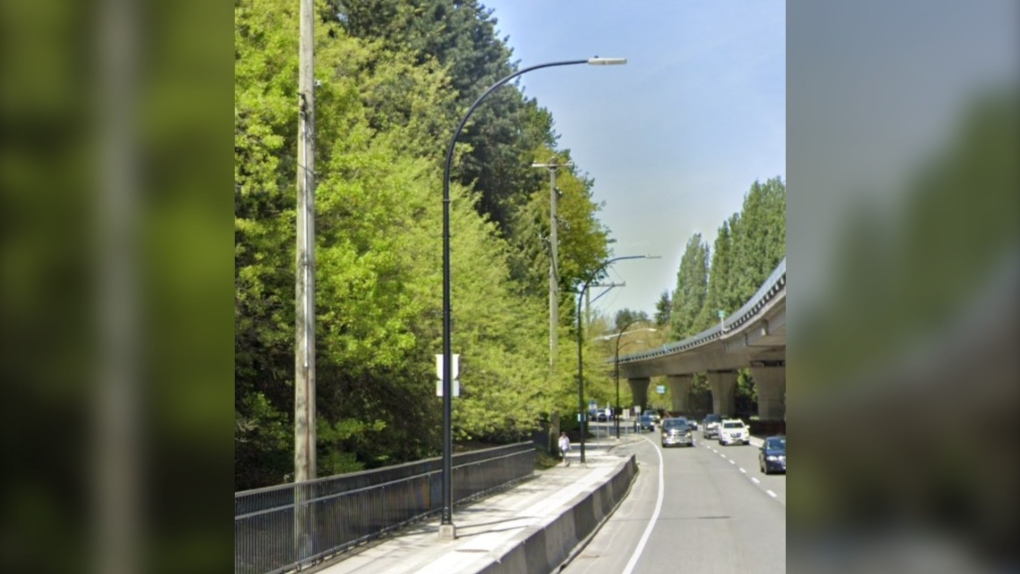Woman who walked into B.C. city's darkened lamppost loses claim for damages
 A black lamppost is seen in the middle of a sidewalk in Burnaby, B.C., in a Google Maps image captured in May 2022.
A black lamppost is seen in the middle of a sidewalk in Burnaby, B.C., in a Google Maps image captured in May 2022.
A woman who was injured after walking into a darkened lamppost in Burnaby, B.C., has lost a small claims case seeking damages for the mishap.
Tara Scott accused the City of Burnaby of negligence because the streetlight wasn’t functioning at the time of her November 2022 accident – which left her with a fractured metatarsal bone in her foot – and because the post was painted black, making it difficult to see at night.
The lamppost in question, located along Lougheed Highway near Government Street, is also smack in the middle of the sidewalk, Scott told the province’s Civil Resolution Tribunal.
“Ms. Scott says that it was already dark, and she was walking quickly to stay warm,” tribunal member Kristin Gardner wrote in her Oct. 5 decision. “And that because the pole was also painted black and overgrown tree branches obscured her view, she was unable to see the pole before she walked into it.”
Scott asked for $5,000 in damages for lost wages, claiming her injury left her unable to work for two months.
While city records show Scott reported a broken streetlight days after the accident – and that staff subsequently investigated and repaired a blown fuse – the tribunal ultimately found Burnaby was not liable for her injury.
Gardiner noted that to prove negligence, Scott would have to demonstrate that Burnaby owed her a “duty of care” – a legal obligation to prevent foreseeable harm – but that public authorities generally “do not owe a duty of care to public users” of their property when it is managed through reasonable policies.
In this case, the City of Burnaby said it maintains lampposts using a complaints-based system, meaning that staff rely on the public to report broken lights rather than proactively monitoring every one.
There were no records of complaints about the lamppost that injured Scott prior to her accident, according to the decision.
“I find the city’s policy to use a complaints-based system for streetlight maintenance was reasonable and made in good faith, based on available budgetary and staffing resources,” Gardiner wrote.
Pictures from the scene also failed to bolster Scott’s case that the circumstances were ripe for inadvertent collisions.
Gardiner found the lamppost, despite its dark paint, was “readily visible” thanks to light cast from nearby streetlights that were in working order, and that the overgrown tree branches referenced in Scott’s complaint were “relatively high” and wouldn’t obstruct the view of someone on foot.
“Overall, I find that the sidewalk was in reasonably safe condition for people exercising ordinary care for their own safety, which I find generally includes looking in the direction that they are walking,” the tribunal member wrote.
CTVNews.ca Top Stories

'Hell on earth': Ottawa rapper TwoTiime among Canadians displaced by L.A. fires
Ottawa rapper Khalid Omar, who performs under the name TwoTiime, was forced to evacuate his Calabasas condo as wildfires tore through the Los Angeles area this week, leaving the studio where he records in ruins.
Death toll continues to rise as fire crews try to corral Los Angeles blazes before winds return this week
After a weekend spent blocking the explosive growth of fires that destroyed thousands of homes as the death toll continues to rise in the Los Angeles area.
Alberta premier Danielle Smith meets with Trump at impromptu Mar-a-Lago visit
Alberta premier Danielle Smith met with President-elect Donald Trump Saturday at Mar-a-Lago in Florida.
Are there U.S. military bases and American troops in Canada?
The U.S. military has more than 165,000 troops deployed in over 170 countries and territories, including Canada.
Costco Canada accused of overcharging online shoppers in class-action lawsuit
Perrier Attorneys says Costco charged more for items online than in-store, a practice known as “double ticketing,” which is banned under the Competition Act.
Meet Franklin, the rescued tortoise who spent the last three months in a B.C. fridge
Franklin the tortoise has been in a fridge for the past 15 weeks.
Teen's road test halted by stunt driving charge
A 17-year-old driver failed their road test before it even began after being stopped by police in a community safety zone.
'He was a genius': Family remembers man who died waiting for care in Winnipeg ER
The sister of a man who died waiting for care in the emergency department of Winnipeg’s Health Sciences Centre (HSC) is remembering her late brother as an intelligent person with a bold personality
Former PM Chretien says Liberal party must move back to 'radical centre'
As the Liberal party searches for a new leader, former prime minister Jean Chretien says it's time for the party to move back to the "radical centre" to help its electoral fortunes.
































